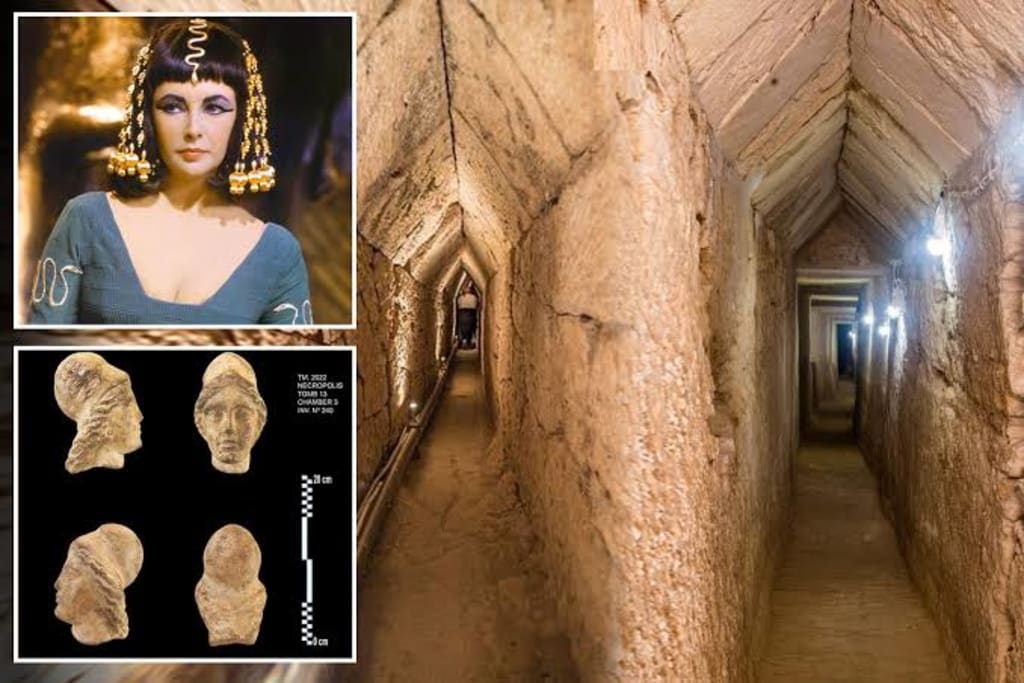The Enduring Mystery of Cleopatra's Tomb
The mysterious tomb

Cleopatra VII, the last queen of Egypt, is a figure shrouded in mystery and romance. Her life, filled with political intrigue, passionate love affairs, and dramatic power struggles, has fascinated historians and the public alike for centuries. Yet, one of the most captivating mysteries surrounding Cleopatra is the location of her final resting place. Despite numerous efforts, the tomb of Cleopatra and her lover, Mark Antony, remains elusive, prompting endless speculation and exploration.
The Historical Context
Cleopatra reigned as the last active ruler of the Ptolemaic Kingdom of Egypt, a dynasty of Greek origin that lasted for nearly three centuries following the death of Alexander the Great. Cleopatra's reign was marked by her intelligence, political acumen, and her alliances with powerful Roman figures such as Julius Caesar and Mark Antony. Following the defeat of Antony and Cleopatra by Octavian (later Augustus Caesar) at the Battle of Actium in 31 B.C., the lovers retreated to Alexandria, where they ultimately took their own lives.
According to ancient sources, notably Plutarch, Cleopatra and Antony were buried together in a "lofty and beautiful" tomb near a temple dedicated to the goddess Isis. This account, while romantic and vivid, provides few concrete clues about the tomb's exact location.
Early Searches and Theories
The quest to find Cleopatra's tomb has intrigued archaeologists and historians for centuries. One prevailing theory suggests that the tomb lies somewhere in Alexandria, the city that served as Cleopatra's capital and the cultural heart of her kingdom. However, Alexandria's coastline has changed dramatically over the millennia due to natural disasters such as earthquakes and tsunamis. Much of the ancient city now lies underwater, making the search for the tomb an immense challenge.
In the early 20th century, several expeditions sought to locate Cleopatra's tomb within the sunken parts of Alexandria. Despite uncovering a wealth of artifacts and structures, no definitive evidence of the tomb was found. The idea that the tomb might be submerged added an additional layer of difficulty to an already daunting task.
Taposiris Magna: A New Hope
In recent years, the most promising leads have come from the temple complex of Taposiris Magna, located about 30 miles west of Alexandria. This site, which features ruins dating back to the time of Cleopatra, has been extensively excavated by a team led by Dominican archaeologist Kathleen Martinez. Martinez has long believed that Taposiris Magna could be the final resting place of Cleopatra and Mark Antony.
Excavations at Taposiris Magna have uncovered numerous significant artifacts, including coins bearing the images of Cleopatra and Alexander the Great, statues, and various burial chambers. Notably, a number of mummies have been found, some adorned with golden masks, hinting at a burial of significant individuals. While these discoveries have fueled excitement, none have conclusively pointed to the tomb of Cleopatra herself.
Why the Tomb Remains Elusive
Several factors contribute to the ongoing mystery of Cleopatra's tomb. Firstly, the historical records are sparse and often contradictory. Ancient writers like Plutarch and Cassius Dio provide tantalizing hints but lack detailed descriptions that could guide modern archaeologists. Furthermore, Alexandria's tumultuous history of conquests and natural disasters has likely disrupted or destroyed many potential sites.
Additionally, the political and religious significance of Cleopatra and Antony's burial would have made it a target for subsequent rulers who sought to erase their legacy. Octavian, who became Augustus Caesar, had every reason to downplay Cleopatra's influence and might have ordered the destruction or concealment of their tomb.
Modern Technology and Future Prospects
The search for Cleopatra's tomb continues to evolve with advances in technology. Modern archaeological techniques, such as ground-penetrating radar and underwater exploration tools, offer new ways to investigate both terrestrial and submerged sites. These technologies have already provided new insights into Alexandria's ancient landscape and could eventually lead to the discovery of the elusive tomb.
International interest in Cleopatra's tomb remains high, with numerous academic and commercial expeditions launched in recent years. The allure of finding such a historically significant site ensures that the quest will continue, combining traditional archaeological methods with cutting-edge technology.
The Legacy of Cleopatra
While the physical location of Cleopatra's tomb remains unknown, her legacy endures. Cleopatra is remembered as a powerful and intelligent leader, a shrewd diplomat, and a woman of great charisma and beauty. Her life and death have inspired countless works of art, literature, and popular culture, ensuring that her story continues to captivate audiences worldwide.
The search for Cleopatra's tomb is more than just a hunt for ancient treasure; it is a quest to uncover a pivotal chapter in human history. Each discovery brings us closer to understanding the complex web of politics, culture, and personal ambition that defined Cleopatra's era. Whether or not the tomb is ever found, the enduring mystery serves as a testament to Cleopatra's lasting impact on history and the human imagination.
Conclusion
The mystery of Cleopatra's tomb remains one of the most tantalizing puzzles of archaeology. As explorers and scholars continue their quest, the potential discovery of the tomb promises to shed light on one of history's most fascinating figures. Until then, Cleopatra's story continues to enthrall, reminding us of the enduring power of history and myth.
About the Creator
Enjoyed the story? Support the Creator.
Subscribe for free to receive all their stories in your feed. You could also pledge your support or give them a one-off tip, letting them know you appreciate their work.






Comments
There are no comments for this story
Be the first to respond and start the conversation.